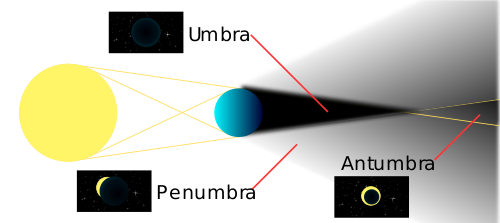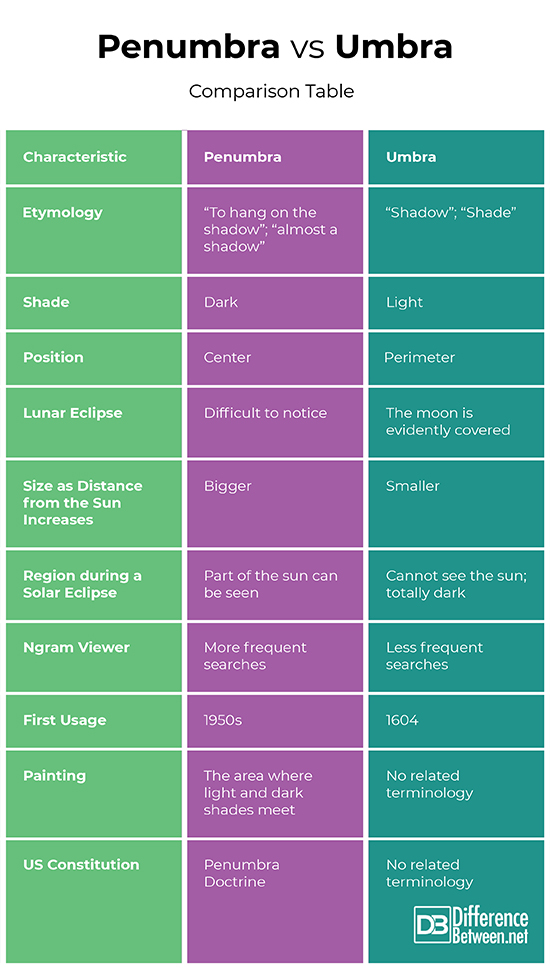Difference Between Penumbra and Umbra
“Penumbra” and “umbra” are terms pertaining to the parts of shadows. Basically, the umbra is the darkest area while the penumbra is the lighter region which is found at the perimeter. They are often associated with astronomy specially when it comes to eclipses. For instance, a lunar eclipse occurs when the moon passes through the earth’s umbra. The following discussions further delve into their distinctions.
What is Penumbra?
“Pen” is derived from the Latin word “pendere” which means “to hang”. Another Latin origin is “paene” which means “almost”. As “umbra” translates to “shadow”, the penumbra is the lighter part which “hangs on the shadow” or that which is “almost a shadow”. “Penumbra” was coined by a German astronomer and mathematician, Johannes Kepler in 1604. He utilized the word to aptly describe the blurry shadow surrounding an eclipse. It is not a true shadow as it is only a gradient of the umbra. Regarding eclipses, it is the region of partial illumination. It is also defined as a sunspots’ gray area which surrounds the dark center.
Though penumbra is mainly associated with shadows and eclipses, it also has the following definitions:
- A surrounding area or region
- A guaranteed bill of rights by implication
- Something that obscures or covers
- Indefinite or marginal
What is Umbra?
“Umbra” was figuratively used in the 1590s to denote “ghost” or “phantom”. This definition was derived from its Latin counterpart which is “shadow” or “shade”. The umbra is the darkest part of a shadow and it is the one directly behind the object which a light source impinges on. It is also defined as the shadow’s conical part which is caused by the exclusion of light. Moreover, it is the innermost dark area of a sunspot. We are very familiar with the earth’s umbra as it is what we know as “night”.
Difference between Penumbra and Umbra
Etymology
“Umbra” means “shadow” while “penumbra” means “to hang on the shadow” or “almost a shadow”. Also, “penumbra” was coined by Johannes Kepler whereas the coining of “umbra” is not attributed to anyone in particular.
Shade
Umbra is the dark part while penumbra is the lighter part. “Umbra” is similarly defined as “shade” while “penumbra” means “partial shade”.
Position
The penumbra is situated at the perimeters while the umbra is at the center, directly behind the object. Correspondingly, “penumbra” is synonymous with “marginal”.
Lunar Eclipse
During a total lunar eclipse, the earths’ inner shadow or umbra falls directly on the moon and at mid-eclipse, the moon may look blood red as it is entirely covered with shadow. When a partial lunar eclipse occurs, the umbra merely covers a part of the moon. On the other hand, only the outer shadow of the earth falls on the moon during a penumbral lunar eclipse. This makes it difficult for most people to notice the change as the moon only appears to have a dark shading.
Size in Relation to Distance from the Sun
During an eclipse, the umbra gets smaller as the distance from the sun increases. On the contrary, the penumbra gets bigger as the distance from the sun increases.
Solar Eclipse
If it is very dark during a solar eclipse, it means that you are situated in the umbra region. If you only see a part of the sun as if a bite has been taken out of it, you are in the penumbra region.
Ngram Viewer
According to the Ngram Viewer, the highest recorded statistics for “umbra” was in 1813 while that of “penumbra” was in 1873. This may be due to the fact that in 1813, there was an annular solar eclipse on February 1 and a total solar eclipse on July 27. Also, in 1873, there were partial solar eclipses on May 26 and November 20. In addition, there were more searches for “penumbra” as compared to “umbra” over the years.
First Usage
“Umbra” was first used in the 1590s while “penumbra” was coined in 1604. The latter’s origin is more definite as it was notably created in relation to astronomy.
Painting
In painting, the penumbra is the area where light and dark shades meet. It is the boundary between stark brightness and full shade or dark. However, umbra is not a specific painting terminology.
Constitution of the United States of America (USA)
In the US constitution, the “penumbra doctrine” is the implied rights which arise from a certain rule. As for “umbra” there is no pertinent legislative term.
Penumbra vs Umbra: Comparison Table
Summary of Penumbra vs Umbra
- Penumbra and umbra are terms which physicists use in describing the volume of shadows. They are often associated with astronomy specially when it comes to eclipses.
- “Penumbra” was coined by Kepler, a German astronomer and mathematician.
- “Umbra” was figuratively used in the 1590s to denote “ghost” or “phantom”.
- “Umbra” means “shadow” while “penumbra” means “to hang on the shadow”.
- The umbra is darker than the penumbra.
- The penumbra surrounds the umbra.
- A penumbral lunar eclipse is usually difficult to notice.
- During a solar eclipse, you would be in the umbra region if there would be darkness while you would be in the penumbra if you would see a “partial” sun.
- There are more searches for “penumbra” as compared to “umbra” according to the Ngram Viewer.
- Umbra was first used in the 1950s while penumbra was coined in 1604.
- Unlike “umbra”, “penumbra” is also a terminology used in painting and in the US constitution.
- Unlike “penumbra”, “umbra” has less variations regarding its meanings and usage.
- Difference Between Hematoma and Melanoma - February 9, 2023
- Difference Between Bruising and Necrosis - February 8, 2023
- Difference Between Brain Hematoma and Brain Hemorrhage - February 8, 2023
Search DifferenceBetween.net :
Leave a Response
References :
[0]Image credit: https://upload.wikimedia.org/wikipedia/commons/thumb/0/0d/Umbra01.svg/500px-Umbra01.svg.png
[1]Image credit: https://upload.wikimedia.org/wikipedia/commons/0/0f/Umbra.jpg
[2]Brewer, Bryan. Eclipse. Seattle, WA: Earth View Inc., 2017. Print.
[3]Littman, Mark and Espenak, Fred. Totality: The Great American Eclipses of 2017 and 2024. Oxford, UK: Oxford University Press, 2017. Print.
[4]Longo, Carlos. Method for the Calculating of Spacecraft Umbra and Penumbra Shadow Termination Points. Washington, DC: NASA Center, 1995. Print.



